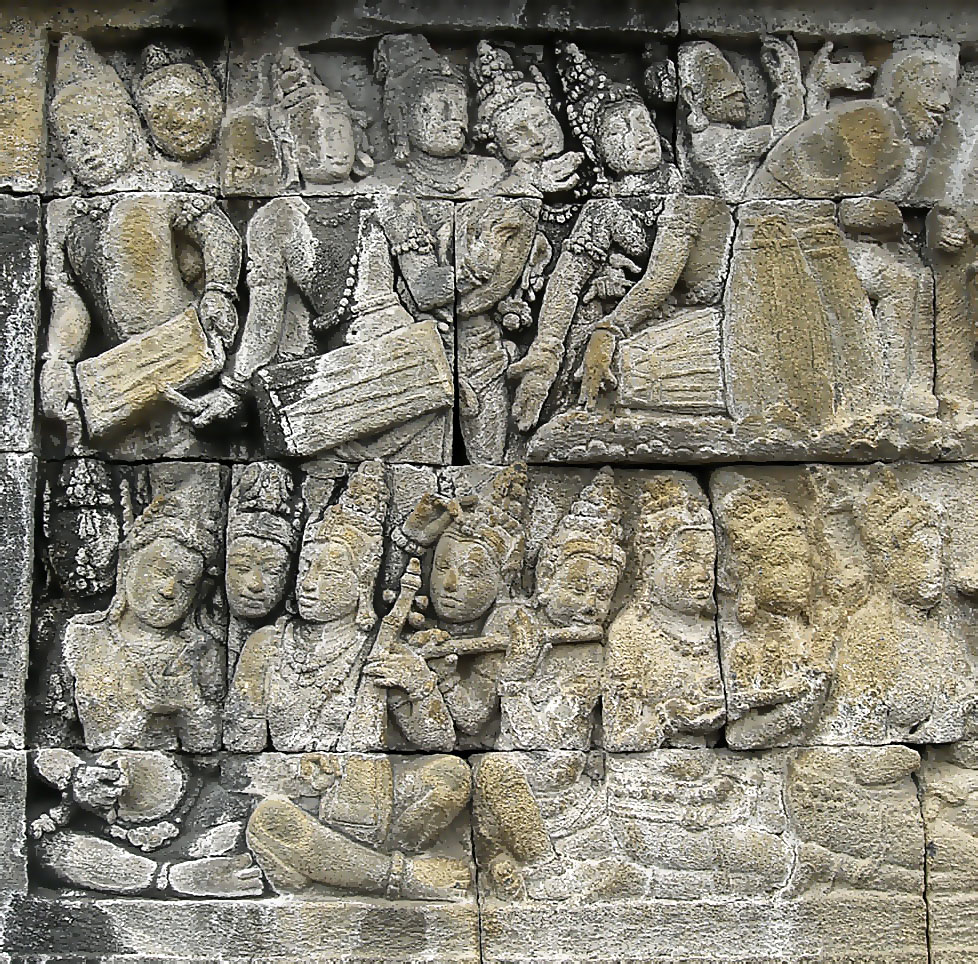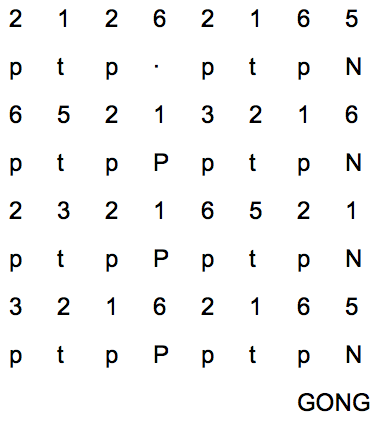|
Bonang
The bonang is an Music of Indonesia, Indonesian musical instrument used in the Javanese people, Javanese gamelan. It is a collection of small gongs (sometimes called "kettles" or "pots") placed horizontally onto strings in a wooden frame (''rancak''), either one or two rows wide. All of the kettles have a central boss, but around it the lower-pitched ones have a flattened head, while the higher ones have an arched one. Each is tuned to a specific pitch in the appropriate scale; thus there are different bonang for pelog and slendro. They are typically hit with padded sticks (''tabuh''). This is similar to the other cradled gongs in the gamelan, the kethuk, kempyang, and kenong. Bonang may be made of forged bronze, welded and cold-hammered iron, or a combination of metals. In addition to the gong-shaped form of kettles, economical bonang made of hammered iron or brass plates with raised bosses are often found in village gamelan, in Suriname-style gamelan, and in some American gam ... [...More Info...] [...Related Items...] OR: [Wikipedia] [Google] [Baidu] |
Bonang Barung
The bonang is an Indonesian musical instrument used in the Javanese gamelan. It is a collection of small gongs (sometimes called "kettles" or "pots") placed horizontally onto strings in a wooden frame (''rancak''), either one or two rows wide. All of the kettles have a central boss, but around it the lower-pitched ones have a flattened head, while the higher ones have an arched one. Each is tuned to a specific pitch in the appropriate scale; thus there are different bonang for pelog and slendro. They are typically hit with padded sticks (''tabuh''). This is similar to the other cradled gongs in the gamelan, the kethuk, kempyang, and kenong. Bonang may be made of forged bronze Bronze is an alloy consisting primarily of copper, commonly with about 12–12.5% tin and often with the addition of other metals (including aluminium, manganese, nickel, or zinc) and sometimes non-metals (such as phosphorus) or metalloid ..., welded and cold-hammered iron, or a combinatio ... [...More Info...] [...Related Items...] OR: [Wikipedia] [Google] [Baidu] |
Gamelan
Gamelan (; ; , ; ) is the traditional musical ensemble, ensemble music of the Javanese people, Javanese, Sundanese people, Sundanese, and Balinese people, Balinese peoples of Indonesia, made up predominantly of percussion instrument, percussive instruments. The most common instruments used are metallophones (played with mallets) and a set of hand-drums called ''kendang'', which keep the beat (music), beat. The ''kemanak'', a banana-shaped idiophone, and the ''gangsa'', another metallophone, are also commonly used gamelan Musical instrument, instruments on Bali. Other notable instruments include xylophones, bamboo flutes (similar to the Indian ''bansuri''), a bowed string instrument called a ''rebab'' (somewhat similar to the ''gadulka'' of Bulgaria), and a zither-like instrument called a ''siter'', used in Javanese gamelan. Additionally, vocalists may be featured, being referred to as ''sindhen'' for females or ''gerong'' for males.Sumarsam (1998)''Introduction to Javanese ... [...More Info...] [...Related Items...] OR: [Wikipedia] [Google] [Baidu] |
Music Of Indonesia
Indonesia is a country with many different tribes and ethnic groups, and its music is also very diverse, coming in hundreds of different forms and styles. Every region has its own culture and art, and as a result traditional music from area to area also uniquely differs from one another. For example, each traditional type of music is often accompanied by its very own dance and theatre. Contemporary music scene have also been heavily shaped by various foreign influences, such as America, Britain, Japan, Korea, and India. The music of Java, Sumatra, Bali, Flores (Lesser Sunda Islands) and other islands have been well documented and recorded, and further research by Indonesian and international scholars is also ongoing. The music in Indonesia predates historical records, various Native Indonesian tribes often incorporate chants and songs accompanied with musical instruments in their rituals. The contemporary music of Indonesia today is also popular amongst neighbouring countries ... [...More Info...] [...Related Items...] OR: [Wikipedia] [Google] [Baidu] |
Kempyang
The kempyang and ketuk are two instruments in the gamelan ensemble of Indonesia, generally played by the same player, and sometimes played by the same player as the kenong. They are important beat-keepers in the colotomic structure of the gamelan. Depending on the structure, they play different, repeating patterns every gongan. Not all structures use the kempyang, but the kempyang is never played without the ketuk. They are shaped like bonang, but are generally placed in their own frame (''rancak''). The kempyang is pitched higher (about one octave, although it depends if they are in the pelog or slendro set. Both have a central boss like the bonang, but the kempyang has a rounder top (like the higher bonangs), while the ketuk has a flat top (like the lower bonangs). In the common numerical notation, kempyang strokes are marked by "-" while the ketuk is marked by "+". The ketuk pattern is used to classify longer gendhing types, where it refers to the number of ketuk strokes in ... [...More Info...] [...Related Items...] OR: [Wikipedia] [Google] [Baidu] |
Demung
The saron is a musical instrument of Indonesia, which is used in the gamelan. It normally has seven bronze bars placed on top of a resonating frame (''rancak''). It is usually about 20 cm (8 in) high, and is played on the floor by a seated performer. In a pelog scale, the bars often read 1-2-3-5-6-7 across (the number four is not used because of its relation to death) (in kepatihan numbering); for slendro, the bars are 6-1-2-3-5-6-1; this can vary from gamelan to gamelan, or even among instruments in the same gamelan. Slendro instruments commonly have only six keys. It provides the core melody ( balungan) in the gamelan orchestra. Varieties Sarons typically come in a number often sizes, from smallest to largest: *Saron panerus (also: peking) *Saron barung (sometimes just saron) *Saron demung (often just called demung) Each one of those is pitched an octave below the previous. The slenthem or slentho performs a similar function to the sarons one octave below th ... [...More Info...] [...Related Items...] OR: [Wikipedia] [Google] [Baidu] |
Slenthem
The slenthem (also slentem or gender panembung) is an Indonesian metallophone which makes up part of a Javanese gamelan orchestra. The slenthem is part of the gendér family. It consists of a set of bronze keys comprising a single octave: there are six keys when playing the slendro scale and seven when playing the pelog. These keys are suspended by leather cords over individual bamboo tube resonators in a wooden frame, which are cut so that the placement of the bamboo's node causes the functional length of the resonator to be shorter for higher notes. The instrument is played by striking the keys with a mallet, called a ''tabuh'', which has a short handle and a thin wooden disk edged in cloth or rubber. One hand is left free to dampen notes. It is a low-pitched instrument with a softer sound than the saron demung. Like the saron barung and demung, it generally plays the most basic form of the melody (balungan) in a composition. However it also sometimes uses techniques sim ... [...More Info...] [...Related Items...] OR: [Wikipedia] [Google] [Baidu] |
Balungan
The ''balungan'' () is sometimes called the "core melody" or, "skeletal melodic outline," of a Javanese gamelan composition. This corresponds to the view that gamelan music is heterophonic: the ''balungan'' is then the melody which is being elaborated. "An abstraction of the inner melody felt by musicians," the ''balungan'' is, "the part most frequently notated by Javanese musicians, and the only one likely to be used in performance."Anderson Sutton, Richard (1991). ''Traditions of Gamelan Music in Java: Musical Pluralism and Regional Identity'', p.xix. Cambridge University. . The group of instruments which play the closest to the ''balungan'' are sometimes also called the ''balungan'', or ''balungan'' instruments. These are the '' saron'' family and the '' slenthem''. In many pieces, they play the ''balungan''. However, they can also elaborate on the parts in a variety of techniques. It is possible that there is no instrument playing the ''balungan'', although many musicians cl ... [...More Info...] [...Related Items...] OR: [Wikipedia] [Google] [Baidu] |
Kenong
The Kenong is a musical instrument of Indonesia used in the gamelan. It is a kind of gong and is placed on its side. It has the same length and width. Thus, it is similar to the bonang, kempyang, and ketuk, which are also cradled gongs. Kenongs are generally much larger than the aforementioned instruments. However, the kenong has a considerably higher pitch. Its sound stands out because of its unique timbre. The kenong sticks are taller than that of the bonang. The kenong is sometimes played by the same player as the kempyang and ketuk. Most of the instruments in the gamelan 'family'. are originally from Java, Indonesia but spread to Southeast Asia. The kenong usually has a specific part in the colotomic structure of the gamelan, marking off parts of a structure smaller than a gongan (the space between each strike of the gong). The interval of each part between strikes of a kenong is called a . In a fast, short structure these can only last a second or so; in a longer gendh ... [...More Info...] [...Related Items...] OR: [Wikipedia] [Google] [Baidu] |
Saron Panerus
The saron is a musical instrument of Indonesia, which is used in the gamelan. It normally has seven bronze bars placed on top of a resonating frame (''rancak''). It is usually about 20 cm (8 in) high, and is played on the floor by a seated performer. In a pelog scale, the bars often read 1-2-3-5-6-7 across (the number four is not used because of its relation to death) (in kepatihan numbering); for slendro, the bars are 6-1-2-3-5-6-1; this can vary from gamelan to gamelan, or even among instruments in the same gamelan. Slendro instruments commonly have only six keys. It provides the core melody ( balungan) in the gamelan orchestra. Varieties Sarons typically come in a number often sizes, from smallest to largest: *Saron panerus (also: peking) *Saron barung (sometimes just saron) *Saron demung (often just called demung) Each one of those is pitched an octave below the previous. The slenthem or slentho performs a similar function to the sarons one octave below the de ... [...More Info...] [...Related Items...] OR: [Wikipedia] [Google] [Baidu] |
Kethuk
The kempyang and ketuk are two instruments in the gamelan ensemble of Indonesia, generally played by the same player, and sometimes played by the same player as the kenong. They are important beat-keepers in the colotomic structure of the gamelan. Depending on the structure, they play different, repeating patterns every gongan. Not all structures use the kempyang, but the kempyang is never played without the ketuk. They are shaped like bonang, but are generally placed in their own frame (''rancak''). The kempyang is pitched higher (about one octave, although it depends if they are in the pelog or slendro set. Both have a central boss like the bonang, but the kempyang has a rounder top (like the higher bonangs), while the ketuk has a flat top (like the lower bonangs). In the common numerical notation, kempyang strokes are marked by "-" while the ketuk is marked by "+". The ketuk pattern is used to classify longer gendhing types, where it refers to the number of ketuk strokes in ... [...More Info...] [...Related Items...] OR: [Wikipedia] [Google] [Baidu] |



